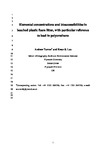Elemental concentrations and bioaccessibilities in beached plastic foam litter, with particular reference to lead in polyurethane
| dc.contributor.author | Turner, Andrew | |
| dc.contributor.author | Lau, KS | |
| dc.date.accessioned | 2016-10-12T15:15:17Z | |
| dc.date.available | 2016-10-12T15:15:17Z | |
| dc.date.issued | 2016-11-15 | |
| dc.identifier.issn | 0025-326X | |
| dc.identifier.issn | 1879-3363 | |
| dc.identifier.uri | http://hdl.handle.net/10026.1/6506 | |
| dc.description.abstract |
Seventy samples of foamed plastic collected from a high-energy, sandy beach in SW England have been characterised by FTIR and XRF. Most samples were polyurethane (PU; n=39) or polystyrene (PS; n=27) that were associated with variable concentrations of Br-Cl, Fe and Zn, indicative of the presence of halogenated flame retardants, iron oxides and Zn-based additives, respectively. Many samples of rigid PU contained Pb, historically used as a catalyst, at concentrations of up to 16,000μgg-1. A physiological extraction test that simulates the conditions in the gizzard of plastic-ingesting seabirds was applied to selected samples and results revealed that while Br and Zn were not measurably bioaccessible, Pb mobilisation progressed logarithmically over a period of time with maximum accessibilities after 220h of ~10% of total metal. Foamed PU is a source of bioaccessible Pb in the marine environment that has not previously been documented. | |
| dc.format.extent | 265-270 | |
| dc.format.medium | Print-Electronic | |
| dc.language | en | |
| dc.language.iso | en | |
| dc.publisher | Elsevier BV | |
| dc.subject | Plastics | |
| dc.subject | Polyurethane | |
| dc.subject | Foams | |
| dc.subject | Seabirds | |
| dc.subject | Lead | |
| dc.subject | Flame retardants | |
| dc.title | Elemental concentrations and bioaccessibilities in beached plastic foam litter, with particular reference to lead in polyurethane | |
| dc.type | journal-article | |
| dc.type | Journal Article | |
| plymouth.author-url | http://gateway.webofknowledge.com/gateway/Gateway.cgi?GWVersion=2&SrcApp=PARTNER_APP&SrcAuth=LinksAMR&KeyUT=WOS:000386188900042&DestLinkType=FullRecord&DestApp=ALL_WOS&UsrCustomerID=11bb513d99f797142bcfeffcc58ea008 | |
| plymouth.issue | 1-2 | |
| plymouth.volume | 112 | |
| plymouth.publication-status | Published | |
| plymouth.journal | MARINE POLLUTION BULLETIN | |
| dc.identifier.doi | 10.1016/j.marpolbul.2016.08.005 | |
| plymouth.organisational-group | /Plymouth | |
| plymouth.organisational-group | /Plymouth/Faculty of Science and Engineering | |
| plymouth.organisational-group | /Plymouth/Faculty of Science and Engineering/School of Geography, Earth and Environmental Sciences | |
| plymouth.organisational-group | /Plymouth/REF 2021 Researchers by UoA | |
| plymouth.organisational-group | /Plymouth/REF 2021 Researchers by UoA/UoA07 Earth Systems and Environmental Sciences | |
| plymouth.organisational-group | /Plymouth/Research Groups | |
| plymouth.organisational-group | /Plymouth/Research Groups/BEACh | |
| plymouth.organisational-group | /Plymouth/Research Groups/Marine Institute | |
| plymouth.organisational-group | /Plymouth/Users by role | |
| plymouth.organisational-group | /Plymouth/Users by role/Academics | |
| dc.publisher.place | England | |
| dcterms.dateAccepted | 2016-08-02 | |
| dc.rights.embargodate | 2017-8-15 | |
| dc.identifier.eissn | 1879-3363 | |
| dc.rights.embargoperiod | 12 months | |
| rioxxterms.versionofrecord | 10.1016/j.marpolbul.2016.08.005 | |
| rioxxterms.licenseref.uri | http://www.rioxx.net/licenses/under-embargo-all-rights-reserved | |
| rioxxterms.licenseref.startdate | 2016-11-15 | |
| rioxxterms.type | Journal Article/Review |


